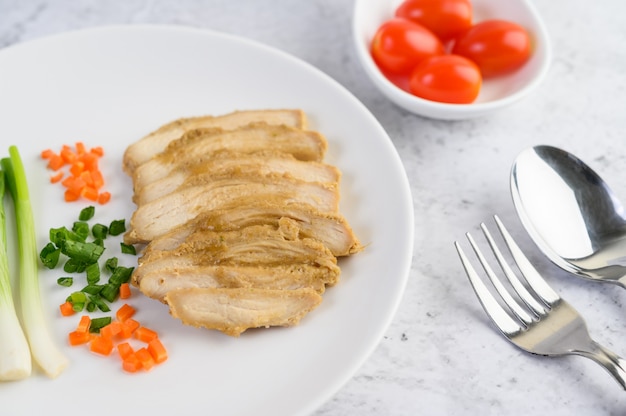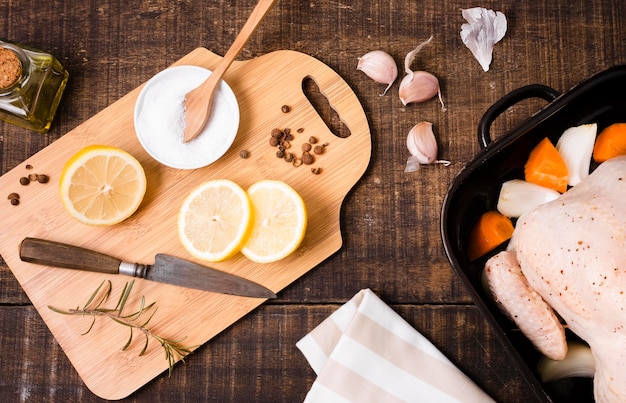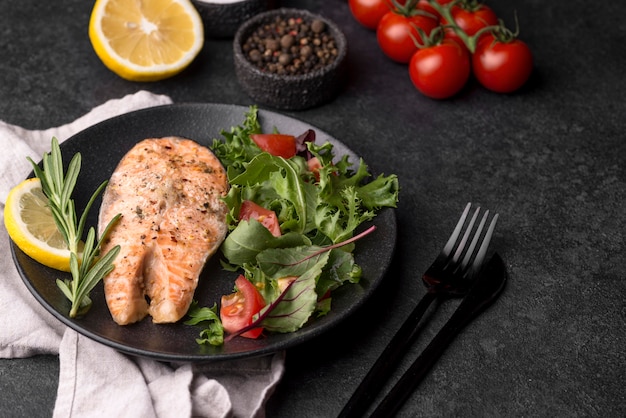Ah, chicken breasts. They're a staple in so many kitchens, a blank canvas for endless culinary adventures. But achieving that perfect balance between tender and juicy, well, that's a bit of an art form. Overcook them and you're left with a dry, rubbery disappointment. Undercook them, and you're playing with fire. So, I'm here to share my secrets, gleaned from years of experimentation and a few happy accidents along the way. We'll delve into the science of chicken breast cooking, explore various cooking methods, and even uncover a few tricks to unlock that succulent, flavorful chicken you've always dreamed of.
(Part 1) Decoding the Science: Understanding the Temperature Game

Before we jump into the kitchen, let's get a bit nerdy. cooking chicken breast isn't just about tossing it in a pan and hoping for the best. It's about understanding how those proteins in the meat respond to heat. Chicken breast, being relatively lean, is prone to drying out if you're not careful.
The Danger Zone: A Culinary No-Man's-Land
You've probably heard the term "danger zone" before, and for good reason. It's the temperature range where bacteria can multiply like crazy. For chicken, this zone is between 40°F (4°C) and 140°F (60°C). You want to get your chicken out of this zone as quickly as possible, which is why cooking it thoroughly is crucial.
Finding the Sweet Spot: The perfect chicken Breast Temperature
The USDA recommends cooking chicken breast to an internal temperature of 165°F (74°C). This ensures it's cooked through and safe to eat. But here's the thing, this temperature can sometimes lead to a bit of dryness. I, for one, prefer a slightly lower temperature, around 155°F (68°C). It still guarantees safety, but keeps the chicken wonderfully juicy and tender. It's all about personal preference, so experiment a bit and find your happy place.
The Resting Ritual: A Crucial Step for Juicy Results
Did you know that chicken breast continues to cook even after you take it off the heat? It's like a slow-burning ember, retaining heat and continuing the cooking process. This is why resting the chicken breast for 5-10 minutes after cooking is so important. It allows the juices to redistribute throughout the meat, resulting in a far more tender and flavorful final product.
(Part 2) Cooking Chicken Breast: A Culinary Adventure Awaits

Chicken breasts are wonderfully versatile, offering a canvas for countless culinary explorations. Each method requires a slightly different approach to ensure the perfect outcome.
Pan-Frying: The Classic for a Weeknight Wonder
Pan-frying is a quick and easy way to cook chicken breasts, perfect for those busy weeknights when you need a delicious meal on the table ASAP. Here's my tried-and-true method:
- Pat Dry: Start by patting the chicken breasts dry with paper towels. This ensures a nice crisp skin.
- Season Generously: Don't be shy with the salt and pepper. You want those flavors to really sing!
- Heat Up the Pan: Heat a tablespoon of olive oil in a heavy-bottomed skillet over medium-high heat. A hot pan is key for a beautiful sear.
- Searing Perfection: Add the chicken breasts to the pan and cook for 4-5 minutes per side, or until they're golden brown and cooked through. That gorgeous golden-brown color is your sign of a well-seared chicken breast.
- Rest and Enjoy: Remove the chicken from the pan and let it rest for 5-10 minutes before slicing and serving.
Baking: Simple and Delicious for a Hands-Off Approach
baking chicken breasts is a fantastic hands-off method, perfect for those times you need to multitask or just want a low-maintenance dinner. Here's what I do:
- Preheat the Oven: Preheat your oven to 375°F (190°C).
- Prepare the Baking Sheet: Place the chicken breasts on a baking sheet lined with parchment paper. This prevents sticking and makes cleanup a breeze.
- Season with Love: Season the chicken generously with salt, pepper, and any other spices you like. I'm a big fan of garlic powder and paprika.
- Bake to Perfection: Bake the chicken for 20-25 minutes, or until the internal temperature reaches 165°F (74°C).
- Rest for Tenderness: Remove the chicken from the oven and let it rest for 5-10 minutes before serving. This resting time allows the juices to redistribute and keeps your chicken moist.
Grilling: Summertime Delight for a Smoky Flavor
grilling chicken breasts is a summertime classic, perfect for warm evenings and outdoor gatherings. Here's how I do it:
- Preheat the Grill: Preheat your grill to medium-high heat. A hot grill ensures those beautiful sear marks.
- Pat Dry: Pat the chicken breasts dry with paper towels. This helps ensure a crispy skin.
- Spice It Up: Season the chicken generously with salt, pepper, and your favorite grilling spices. I love a blend of garlic, onion, and paprika.
- Grill to Perfection: Place the chicken breasts on the grill and cook for 4-5 minutes per side, or until cooked through. Flip them only once to avoid losing precious juices.
- Rest for Flavor: Remove the chicken from the grill and let it rest for 5-10 minutes before slicing and serving.
slow cooker: Effortless Comfort for a Busy Weeknight
The slow cooker is a lifesaver for busy weeknights, transforming chicken breasts into a practically effortless meal. It takes a little longer than other methods, but the results are well worth it.
- Prepare the Slow Cooker: Place the chicken breasts in the slow cooker. You can place them directly on the bottom or on a trivet for even cooking.
- Season to Taste: Season the chicken with salt, pepper, and your favorite slow cooker spices. I love adding onion powder, garlic powder, and paprika.
- Add Liquid: Pour a cup of chicken broth into the slow cooker. This helps keep the chicken moist.
- Slow Cook to Tenderness: Cook the chicken on low for 6-8 hours, or on high for 3-4 hours. The chicken should be tender and cooked through.
- Shred and Enjoy: Remove the chicken from the slow cooker and shred it with two forks. It's perfect for sandwiches, salads, or wraps.
(Part 3) Tips for Success: Your Culinary Toolkit for Perfect Chicken

Here are a few tips to help you achieve consistently perfect chicken breasts. These are the little tricks that elevate your cooking game.
Don't Overcrowd the Pan: Give Your Chicken Room to Breathe
When pan-frying or grilling, avoid overcrowding the pan. This can cause the chicken to steam instead of sear, leading to a soggy, unappetizing texture. It's better to cook the chicken in batches if needed, ensuring each piece gets a chance to brown beautifully.
Embrace the meat thermometer: Your Culinary BFF
A meat thermometer is your best friend when cooking chicken breasts. It takes the guesswork out of knowing when your chicken is cooked through, preventing undercooked chicken and ensuring a safe, delicious meal. I recommend a digital thermometer for instant readings.
Don't Be Afraid to Season: Bring Out the Flavor
Seasoning is a key element in flavorful chicken breasts. Don't be shy with the salt and pepper, and feel free to experiment with other spices like garlic powder, onion powder, paprika, or your favorite herbs. Let your creativity flow!
Embrace Marinating: Infuse Flavor from Within
Marinating chicken breasts in advance can add a depth of flavor that's hard to beat. I love marinating my chicken in a mixture of olive oil, lemon juice, garlic, and herbs. It's a simple trick that elevates any chicken dish.
(Part 4) Chicken Breast Variations: Expanding Your Flavor Horizons
Chicken breasts don't have to be boring. Here are a few flavor combinations to inspire your next culinary creation.
Spicy Chicken Breast: Fire Up Your Dinner
This is a great option for spice lovers. Simply add a generous amount of chili powder, cayenne pepper, or your favorite hot sauce to your chicken breasts before cooking. Adjust the amount of spice to your liking, and enjoy the fiery kick!
Lemon Herb Chicken Breast: A Classic with a Touch of Sunshine
This is a classic combination that's always a crowd-pleaser. Marinate your chicken breasts in a mixture of lemon juice, olive oil, garlic, and your favorite herbs like thyme, rosemary, or parsley. The brightness of the lemon and the earthy notes of the herbs create a symphony of flavor.
Garlic Parmesan Chicken Breast: A Flavorful Italian Delight
This is a winner for a reason. Simply mix garlic powder, parmesan cheese, and a little bit of salt and pepper. Rub this mixture onto your chicken breasts before cooking. The savory aroma and the rich flavor of parmesan cheese will have you coming back for seconds.
Honey Garlic Chicken Breast: Sweet and Savory Harmony
This is a sweet and savory option that's perfect for a special occasion. Combine honey, soy sauce, garlic, and ginger. Marinate your chicken breasts in this mixture for at least 30 minutes. The honey adds a touch of sweetness, while the garlic and ginger deliver a warm, savory depth.
Cajun Chicken Breast: A Spicy Southern Twist
This is a spicy and flavorful option that brings a taste of the South to your table. Use a pre-made Cajun seasoning blend or create your own using paprika, cayenne pepper, garlic powder, onion powder, and other spices. Simply rub the seasoning onto your chicken breasts before cooking. The blend of spices creates a warm, smoky, and slightly spicy flavor profile.
(Part 5) Leftover Magic: Turning Leftovers into New Culinary Adventures
Don't let those leftover chicken breasts go to waste! They're a treasure trove of potential for new and exciting meals.
chicken salad Sandwiches: A Classic comfort food
Simply shred the cooked chicken breasts and combine them with mayonnaise, celery, onion, and your favorite spices. Spread this mixture on bread and you have a delicious and satisfying chicken salad sandwich.
Chicken Soup: A Hearty and Soul-Satisfying Meal
Shred the cooked chicken breasts and add them to your favorite chicken soup recipe. They add a protein boost and a rich, savory flavor to the soup, creating a truly comforting meal.
Chicken Quesadillas: A quick and easy meal
Shred the cooked chicken breasts and add them to a quesadilla with your favorite fillings like cheese, peppers, and onions. It's a quick and easy meal that's perfect for a busy weeknight.
Chicken Stir-Fry: A Flavorful and Versatile Dish
Slice the cooked chicken breasts into strips and add them to your favorite stir-fry recipe. They add a protein boost and a savory flavor to the dish, creating a delicious and satisfying meal.
Chicken Pasta Salad: A Refreshing and Flavorful Option
Shred the cooked chicken breasts and add them to a pasta salad with your favorite vegetables, dressing, and cheese. It's a refreshing and flavorful meal that's perfect for a summer picnic or a light lunch.
(Part 6) Chicken Breast Storage: Keeping It Fresh and Safe
Proper storage is key to keeping your chicken fresh and preventing foodborne illnesses.
Refrigerator Storage: Keep It Cool and Safe
Keep raw chicken breasts in the refrigerator at 40°F (4°C) or below. Store them in the coldest part of the refrigerator, usually the bottom shelf. Be sure to wrap them tightly in plastic wrap or aluminum foil to prevent cross-contamination. Cook chicken breasts within 1-2 days of purchasing for the best quality and flavor.
Freezing Storage: Save for Later
You can freeze raw chicken breasts for up to 2-3 months. Wrap them tightly in plastic wrap or freezer paper, then place them in a freezer-safe bag. To thaw frozen chicken breasts, transfer them from the freezer to the refrigerator overnight. Never thaw chicken at room temperature as this can encourage bacterial growth.
(Part 7) Common Chicken Breast Mistakes: Avoiding the Pitfalls
We've all been there, haven't we? Made a chicken breast mistake or two. Here are a few common pitfalls to avoid, ensuring a smoother culinary journey.
Overcrowding the Pan: Avoid Steaming Instead of Searing
As mentioned before, overcrowding the pan can lead to steamed chicken instead of seared chicken. It's better to cook the chicken in batches if needed, ensuring each piece gets a chance to brown beautifully.
Not Using a Meat Thermometer: Take the Guesswork Out of Cooking
A meat thermometer is essential for ensuring your chicken is cooked through. It takes the guesswork out of cooking chicken breasts, preventing undercooked chicken and ensuring a safe, delicious meal.
Cooking Chicken to the Wrong Temperature: Find Your Ideal Balance
Cooking chicken breasts to an internal temperature of 165°F (74°C) ensures it's safe to eat. However, if you prefer a juicier chicken, you can cook it to a slightly lower temperature, around 155°F (68°C). Just make sure it's cooked through, and use a meat thermometer to ensure safety.
Not Resting the Chicken: Allow for Juicy Redistribution
Resting the chicken breast after cooking allows the juices to redistribute throughout the meat, resulting in a more tender and flavorful chicken. Resting for 5-10 minutes is crucial, allowing those juicy flavors to permeate every bite.
(Part 8) FAQs: Your Chicken Breast Questions Answered
Let's answer some of the most common questions about chicken breasts, helping you navigate the world of chicken with confidence.
1. What are the signs of a cooked chicken breast?
A cooked chicken breast will be opaque in colour, not pink. It should be firm to the touch and there should be no pink juices running when you cut into it. The internal temperature should reach 165°F (74°C).
2. What happens if I overcook chicken breast?
overcooked chicken breast will be dry, tough, and rubbery. It will also lose its flavor and become unappetizing.
3. What happens if I undercook chicken breast?
Undercooked chicken breast can be dangerous to eat because it can contain harmful bacteria. You'll know if your chicken is undercooked if it's still pink inside. Always cook chicken to an internal temperature of 165°F (74°C).
4. How long can I keep cooked chicken breasts in the refrigerator?
You can keep cooked chicken breasts in the refrigerator for 3-4 days. Store them in an airtight container in the refrigerator to maintain freshness and prevent any unwanted flavors from mingling.
5. Can I refreeze cooked chicken breasts?
It's not recommended to refreeze cooked chicken breasts. This can lead to a decrease in quality and an increase in the risk of foodborne illness. It's best to enjoy cooked chicken breasts within a few days for the best flavor and safety.
(Part 9) The Chicken Breast Journey: A Personal Reflection
Over the years, I've learned so much about cooking chicken breasts, from the joys of experimentation to the frustration of a few less-than-perfect attempts. But with each dish, I've developed a deeper appreciation for the versatility of this protein, the endless possibilities for flavor, and the satisfaction of knowing I've created a delicious and satisfying meal.
So, the next time you're craving a juicy, flavorful chicken breast, remember these tips and tricks. Get creative, experiment with flavors, and enjoy the process! Happy cooking!
Everyone is watching

Prime Rib Roast Cooking Time Chart: Per Pound Guide
Cooking TipsPrime rib roast. Just the name conjures images of lavish dinners, crackling fires, and hearty laughter. It’s ...

How Long to Bake Potatoes in the Oven (Perfect Every Time)
Cooking TipsBaked potatoes are a staple in my kitchen. They're incredibly versatile, delicious, and surprisingly easy to m...

Perfect Rice Every Time: The Ultimate Guide to Cooking Rice
Cooking TipsAs a self-proclaimed foodie, I've always been a bit obsessed with rice. It's the foundation of countless cuisi...

The Ultimate Guide to Cooking Asparagus: Tips, Techniques, and Recipes
Cooking TipsAsparagus. The mere mention of this spring delicacy conjures up images of vibrant green spears, crisp and burs...

Ultimate Guide to Cooking the Perfect Thanksgiving Turkey
Cooking TipsThanksgiving. Just the word conjures up images of overflowing tables laden with delicious food, the scent of r...
